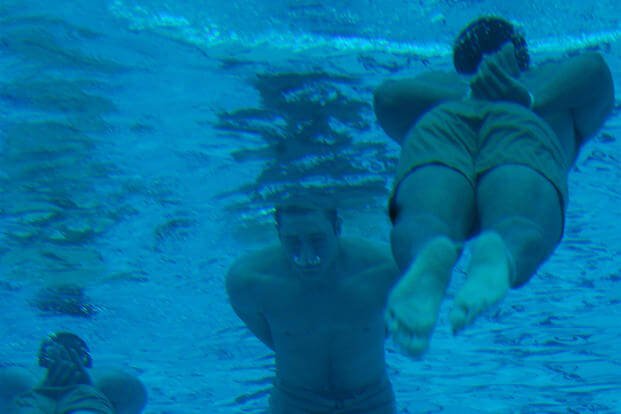Even if you were not a competitive swimmer in high school or college, the right preparation can help you make it through the Department of Defense's toughest military swimming and diving courses. That experience does not hurt, either.
For many land-based athletes with minimal swimming experience, the preparation time before you join may be significantly longer, depending on how quickly you can learn the techniques of swimming, treading and other water competency drills.
You will also have to add more time to get into swimming and treading shape in addition to acquiring the needed skills and general comfort in the water.
Here are some swim workouts I recommend in addition to the classic 50-50 workout:
The 500-Yard or 500-Meter Warmup
Before you start the workout, your ability to warm up with a 500-meter swim without stopping is physiologically and psychologically beneficial. You will likely be tested in the 500-yard or 500-meter distance, depending on your branch of service.
If you say "this 500 is my warmup," you're going to have a much easier time on this challenging section of a fitness test that will also include running and calisthenics incorporated before or after the swim. That will be a powerful advantage as you're going into these competitive special-ops-level candidate tests.
After the "warmup," the workout begins with some goal pace or faster than goal-paced 100m sets:
Repeat 5 times:
- 500-meter swim: 100-meter sprints or goal-paced 100 meters for timed 500-meter swim
- Rest: 1 minute tread or bottom bounce
I recommend working at a pace of a yard or meter per second. This will yield a 500-second (8:20) swim, which is highly competitive and achievable even for land athletes with no swimming background. After each 100-meter set of swimming, work to rest with treading or bottom bouncing in a nine- to 10-foot deep section of the pool for one minute.
Treading is another skill non-swimmers cannot neglect, as it's basically "vertical swimming" and will require just as much attention to detail as swimming.
Fix Your Kick
If you find that your kick is not working, add in some kickboard drills. Test your kick and streamline by measuring how far you can go in the glide position after you kick before you stop moving or sinking. If you can get a two- or three-second glide time without losing speed, that is the sweet spot for making strokes like the side stroke and the combat swimmer stroke more efficient.
Repeat 5 times:
- Kickboard: 25 meters (scissor kick, breaststroke or flutter kick)
- CSS, breaststroke or freestyle (whatever your testing stroke is): 50 meters
- Rest can be treading or bottom bouncing
Fix Your Pull (Arm Stroke)
If you find that your arms are not grabbing water well, consider a set of arm-pulling drills. Search terms like "freestyle catch" and "breaststroke scull" on YouTube to find workouts that will take your pulling and pushing water technique to the next level with some minor adjustments. The goal for these 50-meter sets is to see how few arm pulls it takes to get across the pool.
Repeat 5 times:
- Arm pull only (drag legs or place swim buoy between knees to prevent kicking): 50 meters
You may find you do not need much rest, as learning to swim with fewer kicks is much easier on the heart and lungs.
This workout can be done in a single session and should take about 30-40 minutes, as it is less than 1,600 meters of accumulated distance. This should be a daily minimum standard for any non-swimming athlete preparing for military swimming.
You will eventually need to build up to 4,000 meters with fins, depending on your training, but swimming with fins for an hour nonstop prior to joining military special ops, diving or rescue swimmer programs is a good standard if you want to be successful in your journey.
-- Stew Smith is a former Navy SEAL and fitness author certified as a Strength and Conditioning Specialist (CSCS) with the National Strength and Conditioning Association. Visit his Fitness eBook store if you're looking to start a workout program to create a healthy lifestyle. Send your fitness questions to stew@stewsmith.com.
Want to Learn More About Military Life?
Whether you're thinking of joining the military, looking for fitness and basic training tips, or keeping up with military life and benefits, Military.com has you covered. Subscribe to Military.com to have military news, updates and resources delivered directly to your inbox.


















